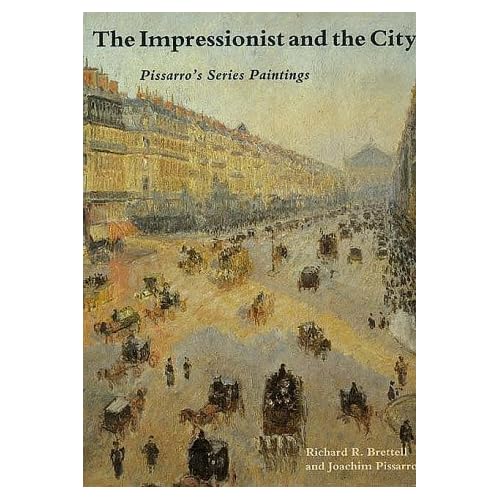The Impressionist and the City: Pissarro's Series Paintings
Category: Books,Arts & Photography,History & Criticism
The Impressionist and the City: Pissarro's Series Paintings Details
From Library Journal The catalog of an exhibition traveling to Dallas, Philadelphia, and London in 1992-93, this book considers approximately 150 paintings done by Pissarro (1830-1903) in the last decade of his life. These paintings are repeated meditations on various motifs in Paris, Rouen, Dieppe, and Le Havre. Brettell (director, Dallas Museum of Art) places Pissarro in the urban view-painting tradition, while Joachim Pissarro, a descendant of the artist, relates these pictures to the artist's development and attempts to understand his intent in painting series. Graced by beautiful plates, this book is appropriate for both lay readers and specialists.- Jack Perry Brown, Art Inst. of Chicago Lib.Copyright 1993 Reed Business Information, Inc. Read more

Reviews
This book is the catalogue to the exhibition of the same name initiated by Richard Brettell in 1992 at the Dallas Museum of Art, of which he was then Director, and which subsequently travelled to the Philadelphia Museum of Art and the Royal Academy of Arts in London. But it is much more than the exhibition catalogue, since roughly half of the paintings illustrated were not exhibited; they have been added to this volume for the sake of completeness, and that makes this into a very comprehensive survey of Pissarro's series paintings. And since about half of the paintings reproduced are in private collections or otherwise not accessible to the public, the result is a major contribution to Pissarro studies.We are justly accustomed to thinking of Pissarro as the most rural of the Impressionist painters, the ultimate landscapist among them; indeed, it was a given for Brettell to underline that in the subtitle of a previous book, "Pissarro and Pontoise: The Painter in a Landscape" (see my review on this website). So it comes as a bit of a surprise to learn that Pissarro was also the ultimate cityscapist among them, producing in the last decade of his life more than 300 paintings and at least as many drawings of Rouen, Paris, Dieppe and Le Havre, and in the process creating, as Brettell notes in his brief introductory essay, "the most sustained contribution to urban view painting by any great artist" since Canaletto well over a century before (xv). As paradoxical as that may seem, it makes sense: Pissarro's quest was always to be a painter of his own epoch, and in order to be that, it is clear that he had to respond to what was probably the most fundamental dichotomy in nineteenth-century French sensibility, namely the profound gulf between the country and the city, between the rural way of life and the urban, which were viewed simultaneously as utterly opposite and completely complementary. Curiously, though, given that Pissarro was creating his great urban series at the same time as Bonnard and Vuillard were painting their own intimate versions of Paris, Pissarro's techniques, as Brettell notes, seem to be less of his time than his subjects: his eye is unblinkingly omniscient and directed always outward; nothing in these paintings invites us to reflect much about the painter himself or his own processes, and so the paintings seem oddly anti-modern; they seem indeed to look more back to Canaletto than forward to the Nabis. Perhaps that is as it should be. Joachim Pissarro points out in his introductory essay that the painter's pictorial imagination was always fired by the juxtaposition of the old and the new or the eternal and the transient, for which he offers many examples--although Brettell points out that neither the most venerable symbol of Paris, Notre-Dame de Paris, nor its newest, the Eiffel Tower, appears in any of the Paris series.All eleven of Pissarro's urban series are presented in roughly chronological order: the initial campaigns in Rouen, all seven of the Paris series, the two in Dieppe and the final one in Le Havre. There are altogether 154 excellent reproductions, mostly one to a page, all with dimensions, location and catalogue raisonne numbers (P&V) and, in the case of the exhibited paintings, listing also provenance, previous exhibitions, and specific bibliography. This apparatus is supplemented by an Appendix presenting an analysis of each series in tabular form and an excellent selected general bibliography. Each series is introduced by a two-to-three-page discussion of the origin of the series, the vantage point from which Pissarro was painting, some relevant quotations from his letters, etc., and there is much valuable information here. As mentioned, each author has a brief introductory essay (about 13 pages each) addressing pertinent topics such as the relation of the paintings to Pissarro's anarchist politics, the importance of the human element in the paintings, and issues of technique and facture (superbly supported by over thirty full-page blowups of details). Factors peculiar to series paintings (both to these series and in general) are also addressed: sequentiality, the "dialectic" of the individual painting to the series, the complementarity of the series themselves, etc. However, if there is one way in which this book may disappoint the reader, it is in the relative brevity of commentary: the authors are two of the very few genuinely preeminent authorities on Pissarro, and although they have written a great deal more about him in other places, one would have liked to see more extended analysis in this particular context. What is especially missing is discussion of the individual paintings such as Joachim Pissarro had provided in his previous book on series paintings, "Monet's Cathedral." Perhaps that is merely an ungrateful cavil; what is certain is that this is a finely produced book full of excellent reproductions of stunningly beautiful paintings, a major contribution for which all lovers of Pissarro's art will be most thankful.


